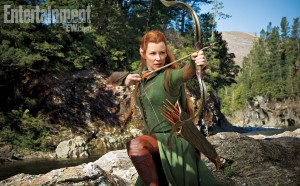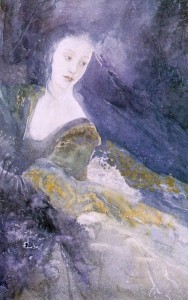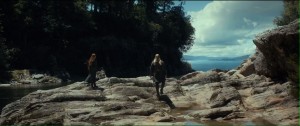 In this thought piece, our newest feature writer Noah Smith outlines some of his hopes and concerns regarding the character Tauriel, and how in her best moments he hopes she’ll prove a tribute to some of most Tolkien’s vibrant heroines.
In this thought piece, our newest feature writer Noah Smith outlines some of his hopes and concerns regarding the character Tauriel, and how in her best moments he hopes she’ll prove a tribute to some of most Tolkien’s vibrant heroines.
NO two Tolkien fans are the same. Yes, we harbor a deep and abiding love for all things Middle-earth, but (I like to believe) our tastes differ, even if only in the minutia. Some may enjoy the philological phantasmagoria that permeates Tolkien’s works, while others draw inspiration from the detailed locations and their histories. Personally, I have a thing for maps. However with the recent addition of Tauriel to the Middle-earth mythos, my thoughts have been drawn to the characters that inhabit our collective imagination and, more specifically, those of the female gender.
Tolkien, unlike many other fantasy writers of the twentieth century, was entirely willing to create strong, vividly imagined female characters. One that immediately comes to mind is Lúthien Tinúviel, who was so prominent in Tolkien’s world that she is not only mentioned in The Lord of the Rings, but is also a major character in The Silmarillion and even features in the epic poem The Lay of Leithian.
 The latter work, which Tolkien never completed, chronicles the love between Beren and Lúthien. Another well-known character from the Legendarium is Elwing the White*, mother of Elrond and Elros. How prominent was she? After several unsuccessful attempts by Eärendil the Mariner to try and sail to Valinor, Middle-earth’s most-renowned seaman was only successful after Elwing joined him on Vingilot.
The latter work, which Tolkien never completed, chronicles the love between Beren and Lúthien. Another well-known character from the Legendarium is Elwing the White*, mother of Elrond and Elros. How prominent was she? After several unsuccessful attempts by Eärendil the Mariner to try and sail to Valinor, Middle-earth’s most-renowned seaman was only successful after Elwing joined him on Vingilot.
The two most well-known heroines, thanks in no part to the films, are of course Arwen and Éowyn. Yes, Arwen’s romance with Aragorn did seem a tad campy on the big screen (in a beautiful, melancholic fashion that truly added to the story), but let’s not forget: this is the same elf who faced down the Nine (even if it didn’t happen in the books) and single-handedly saved Frodo from certain death. And Éowyn’s fantastic line, “I am no man!” when taunted by the Witch-king? It still raises the hairs on the back of my neck. So good. Also, I would be remiss to neglect Galadriel, of Lothlórien. Not only is she a Ring-bearer of immense power, but she also sits upon the predominantly male (even if the Mair aren’t technically Men) White Council.
So, where does this leave us? Ah, yes: Tauriel. As a Tolkien fan, I’m ecstatic to see a fresh addition to the lore. As someone who considers himself to be rather versed in the ways of the entertainment industry, I see it as a shameless attempt to attract the ever-elusive demographic of young women (insert Orlando Bloom joke here) and adolescent males (insert scantily clad bikini picture here). Honestly? If she’s anything more than a Disney princess in elf ears, I’ll be satisfied.
What I’m trying to say, in a less cynical fashion, is that I trust Peter and Fran, I really do. But I’m also aware of the climate in which they have to operate. Big money means a big emphasis on making a big profit, and a necessary part of show business is trying to target as many demographics as possible. Time and time again, we see corporations put pressure on directors and writers to change their movies in ways that reach a larger audience, but harm the overarching narrative.
 Will Evangeline Lilly be fantastic? I’m sure she will. Will her and Orlando’s on-screen chemistry, and indeed their very presence, contribute to the overall narrative of the trilogy? I’m sure they’ll make it work. Is it necessary? I remain to be convinced, largely because I’ve seen how sterile and bureaucratic the industry can be.
Will Evangeline Lilly be fantastic? I’m sure she will. Will her and Orlando’s on-screen chemistry, and indeed their very presence, contribute to the overall narrative of the trilogy? I’m sure they’ll make it work. Is it necessary? I remain to be convinced, largely because I’ve seen how sterile and bureaucratic the industry can be.
In the best of all possible worlds, I see Tauriel as the embodiment of the inner strength and outward beauty of all the aforementioned characters. Why Tauriel? Because The Lord of Rings trilogy had its strong female protagonists, as did the Silmarillion and the Legendarium before it. Therefore, in the spirit of a more diverse, modern telling of The Hobbit, I see it as only natural that Jackson and company would want to introduce a fresh female character. In truth, the only part of me that is uneasy is the fervently cynical, text-obsessed fanboy who’s shaking the bars of his cage and muttering, “but she’s not in the book!”
Until more elements of the plot are revealed, Tauriel remains a positive yet potentially unnecessary addition to Peter Jackson’s cinematic vision. In the end it all boils down to the spirit in which these changes are made to the source material. Who knows? I could be completely off the mark. When it comes to the Hobbit films I’ve yet to be disappointed.
In Jackson we trust.
* Bootnote. Most would automatically think of Aredhel with the appellation “the White”. However, there is one single reference that seems to indicate that the label also applied to Elwing. It’s from The Fellowship of the Ring where Aragorn is speaking to the four hobbits of Beren and Lúthien. As it’s direct speech, it does seem to be part of an oral tradition of either the Dunedain, or of the Noldor (or both). The quote in full: “For of Beren and Lúthien was born Dior Thingol’s heir; and of him Elwing the White whom Eärendil wedded, he that sailed his ship out of the mists of the world into the seas of heaven with the Silmaril upon his brow. And of Eärendil came the Kings of Númenor, that is Westernesse.” A Knife in the Dark, The Fellowship of the Ring.
Noah Smith is a freelance writer operating out of the woods of Pennsylvania, though he leaves often and for great lengths of time. The proud owner of more pet projects than any sane person deserves, he peddles his craft in various portions of the internet and local collegiate magazines, writing poetry, commentary, speculative fiction and erroneous remarks in the comment sections of videos. He writes on a blog called Utumbria and can also be found on Twitter. His opinions do not necessarily reflect those of TheOneRing.net or its staff.


